10 Most Famous Scary Paintings for Halloween
Centuries agone, paintings were one of the few ways that artists could convey visual messages and images to their viewers. Throughout history, there have been a litany of different works that focused on various themes from life and decease to love, nature, and many other facets of human life.
Some painters produced works that touched on the horror chemical element and created nighttime, sinister paintings that played on some of the deepest fears that people accept.
Many of these works have somewhat of a religious element to them as people from centuries agone were much more heavily-focused on their own specific religious behavior compared to today.
In addition to these demonic paintings are works that depict other scenes of terror and dread from diverse aspects of human existence.
In this commodity, we've compiled 10 of the nigh famous scary paintings from history and included the story behind many of these paintings to give you an explanation of their reasons for creating the work, likewise as the effect they hoped to have on viewers.
Famous Scary Paintings
1. Dante And Virgil – William-Adolphe Bouguereau
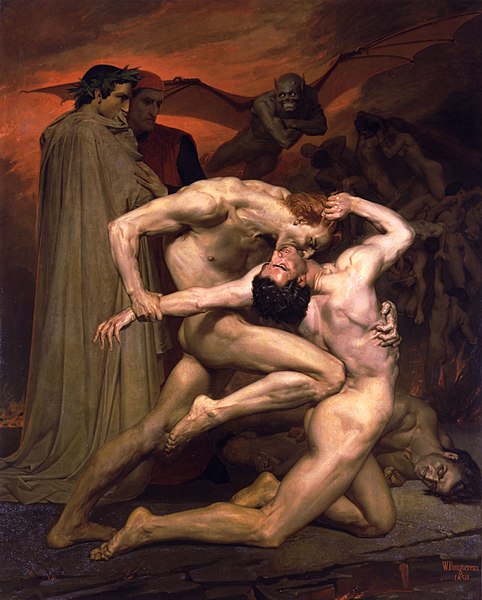
In the 14th century, Dante's Divine Comedy was the stuff of nightmares for many people in southern Europe. Written by Dante Alighieri in 1308, the long-course poem told a horrifying tale of one human's journeying through the depths of hell.
The story tells of at that place beingness nine different levels of the underworld, with each descending level being more evil and terrible than the last.
Several painters have attempted to depict their own interpretations of this poem in their works, but none have washed so with as much acclaim as William-Adolphe Bouguereau.
Also Read: Paintings of Hell
His 1850 painting was done centuries after the verse form was initially written, but seemed to portray the hellish nature of Dante's Divine Comedy much more accurately and vividly than any other artist had e'er done earlier.
The painting focuses on a single scene from the verse form in which Dante is led by his guide, Virgil, to the upper levels of hell where damned souls were tormented much like what is described in the Christian Bible and other religious texts.
he groundwork is filled with peppery, reddish glow and darkness as Dante and Virgil watch two men locked in an eternal struggle with ane another.
2. Study later on Velázquez'southward Portrait of Pope Innocent – Francis Bacon
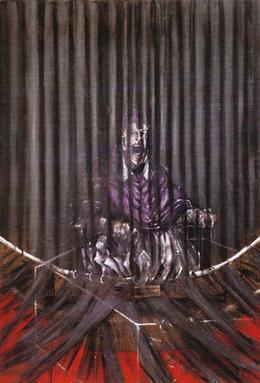
Francis Bacon is remembered as ane of the well-nigh celebrated artists of the 20th century. Built-in in Ireland in 1909, the painter had an early start in the arts and quickly grew addicted of portraying the man course in various themes such as crucifictions, cocky portraits, and other works that were somewhat unique for the fourth dimension menstruum.
Bacon was heavily-influenced by some of the more than notable figures from the Italian Renaissance, as well as Rembrandt and others.
One of his more hitting paintings is known equally Study afterwards Velázquez's Portrait of Pope Innocent. The work was done in 1953 and featured a ghostly, seated version of Pope Innocent that was based on a previous painting done by Velázquez of the 17th century figure.
The pope is seen as a cogitating, misty apparition while the chair and other elements of the painting are too depicted in the same manner.
This was 1 of Bacon'south more controversial works as it depicted such a prominent religious figure as a ghost, which many people—even in the mid-20th century—constitute to exist somewhat disrespectful. Nevertheless, many fine art critics and fans of Bacon's work claim that information technology is one of his greatest masterpieces as information technology combines a somewhat sinister nature to such a notable religious leader.
3. The Library – Félicien Rops
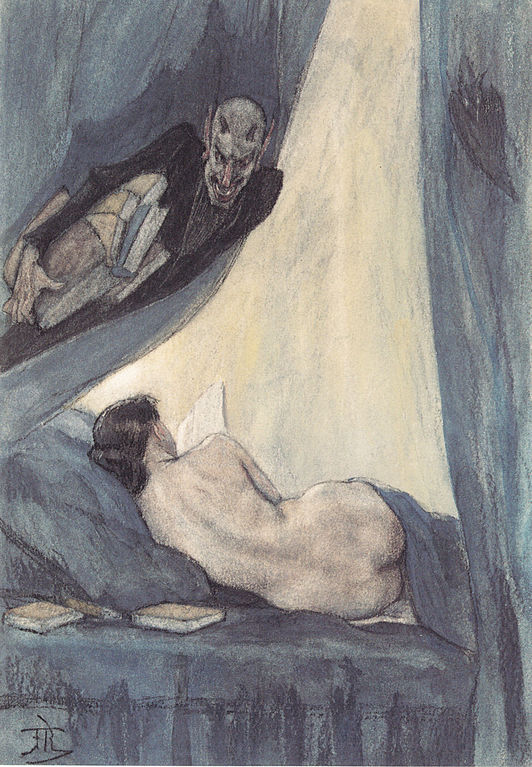
Félicien Rops was a Belgian artist that dabbled in a variety of different mediums including painting, illustration, caricature, and other forms during the 1800'south.
Many of his more notable works portray an overwhelming theme that seemed to eye effectually the occult or demonic nature. This was a style or genre that was seldom explored by artists, even into the 19th century.
What is arguably Rops' most famous work is known equally The Library or The Librarian and was painted in 1878. This painting was one that had a very dark, dreary overall tone mixed with what many describe as a demonic nature.
The painting depicts a nude woman lying in a bed reading a book. She is unaware of a large and sinister-looking demon hovering overhead, holding an arm-full of books as he smiles eerily downwardly at her.
Nigh of Rops' works were considered to exist somewhat erotic and this ane is easily one of the most widely recognized works that he ever created.
iv. Saturn Devouring His Son – Francisco Goya
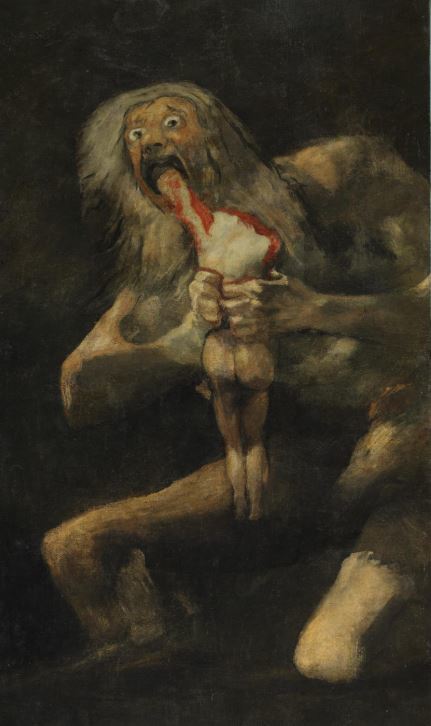
Francisco Goya is i of the more highly-revered painters from the 18th and 19th centuries that focused mostly on works that are described as being part of the Romantic era.
Born in Espana in 1746, Goya would go on to written report much about the Greek and Roman mythology that was very pop amongst artists at the pinnacle of his career.
His most controversial and famous work is titled Saturn Devouring His Son. This painting is widely known for its grotesque delineation of the Greek myth involving Titan Cronus, which is named Saturn. The myth tells a story of Saturn devouring his sons and Goya aimed to portray this tale in gruesome detail.
The painting shows Saturn preparing to bite the left arm of one of his sons, who is seen covered in blood. It is articulate that Saturn has already eaten his son's caput and the level of contrast betwixt lite and dark is very much at work here.
5. Judith Beheading Holofernes – Caravaggio
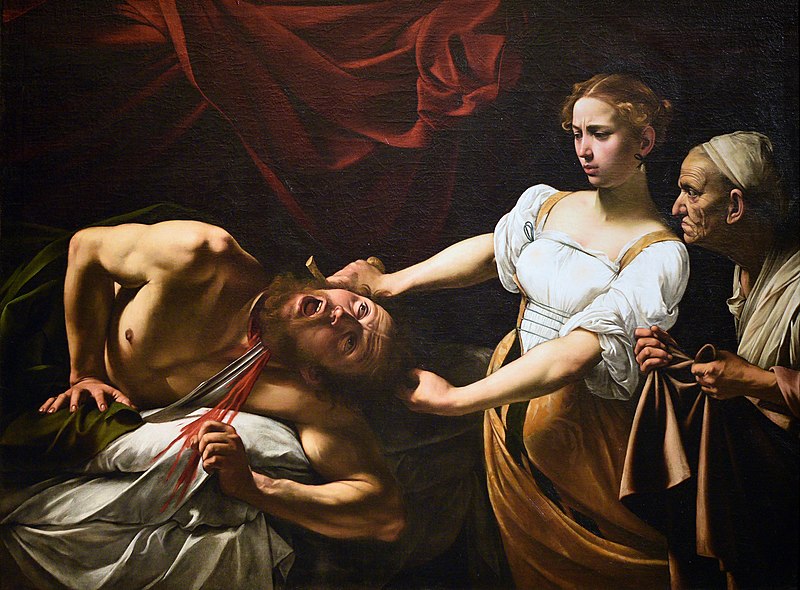
Built-in in the late 16th century, Michelangelo Merisi da Caravaggio would go on to go ane of the most rebellious and celebrated figures of the Baroque era. He was in and out of jail for many duels and fights and was charged with multiple murders throughout his lifetime in Italy and the surrounding area.
But similar the events of his life, many of Caravaggio's paintings were seen as somewhat controversial to an extent.
One of his most well-known religious paintings is as well one that is quite scary in nature. It depicts the story of Judith from the Bible every bit she cuts off the head of Holofernes.
The painting was finished old effectually the year 1600 and was done in vivid item, which Caravaggio was known for.
The work portrays a horrified Holofernes surprised at his demise at the hands of a beautiful and frail adult female similar Judith. Her elderly maid, Abra stands next to her property a blanket which she probable intended to use to cover the face of Holofernes.
6. The Nightmare – Henry Fuseli
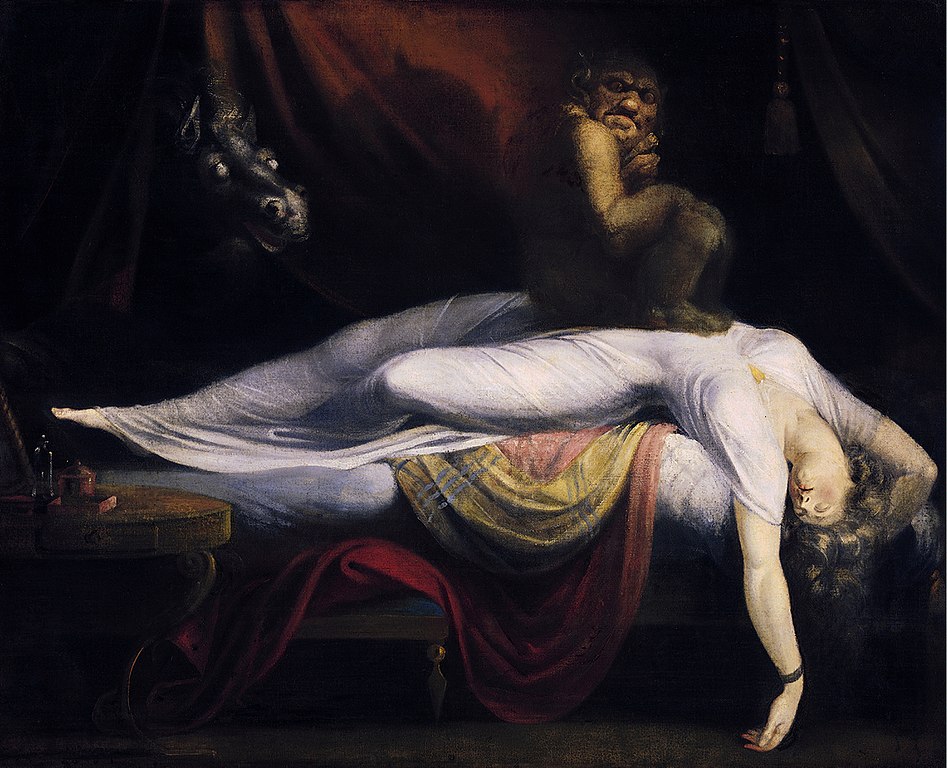
Sleep paralysis is a very real and terrifying phenomenon for thousands of people across the world. Information technology is commonly described in the aforementioned way, with the person existence awake every bit they prevarication in bed, but unable to movement their limbs and head except for the eyes.
These encounters take varied in nature and some have described seeing and feeling some sort of demonic presence positioned on their chest, squeezing the breath out of them as they lie helpless in their bed.
This is precisely the events that are depicted in Henry Fuseli's 1781 work which is titled The Nightmare. It is not articulate whether Fuseli himself dealt with sleep paralysis, or whether he had studied the phenomenon, but his painting shows that he had a articulate understanding of the horrible nature of this blazon of issue.
His painting depicts a sleeping woman lying on a bed with a short, dwarf-like demon perched on her breast. There is another demonic figure that tin can be seen in the groundwork equally well and many critics and historians remember this painting for its agonizing nature.
7. The Massacre Of The Innocents – Peter Paul Rubens
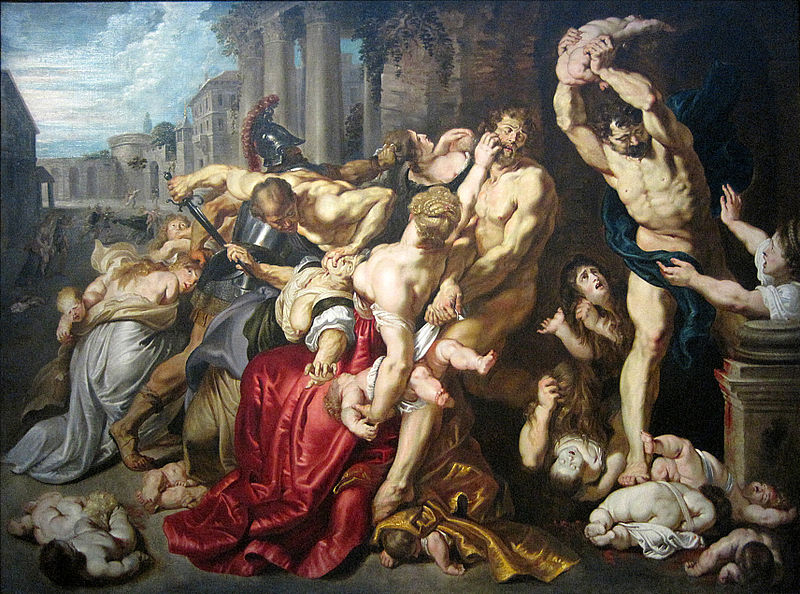
Some of the paintings on our list are not centered effectually the mysterious and the occult, but are instead focused on existent events from human history that are truly horrific. Peter Paul Rubens was a Flemish creative person who lived in the 16th and 17th centuries. He focused largely on religious works in the same way that many other Baroque painters did.
One of his paintings depicted i of the more gut-wrenching stories from the Bible that many historians point out every bit having some supporting details for its validity.
The painting is titled The Massacre Of The Innocents, 1608, and features a scene of a story from the Gospel of Matthew. The story tells of the killing of young boys as part of an awful decree that was given past King Herod of Judea at the fourth dimension soon following the birth of Jesus.
There is some celebrated evidence of this being true as some historians from the time period have referenced the order and the outcome that it had at the time in Judea.
8. Big Electrical Chair – Andy Warhol
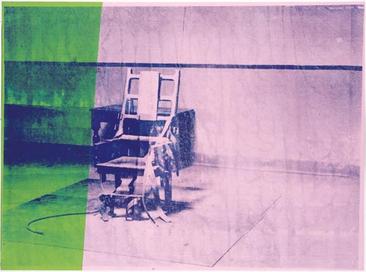
In that location accept been some truly horrendous methods of execution that were used at various times throughout human history with some existence much more fell and unusual than others.
The electric chair was the chosen method of executing those found guilty of terrible crimes during much of the 20th century in the United States. Artist Andy Warhol created on piece of work that focused on this method of execution.
The silk screen ink on synthetic polymer pigment on sail work is titled Big Electrical Chair and was washed in 1964 past Warhol during the summit of popularity for this farthermost method of killing that many regime said to be faster and less cruel than the previous methods like hanging or firing squad.
In that location were some at the time who were against the thought of executing people with the electrical chair and Warhol's painting is a grim and dark reminder of this method during American history.
ix. The Face Of War – Salvador Dalí
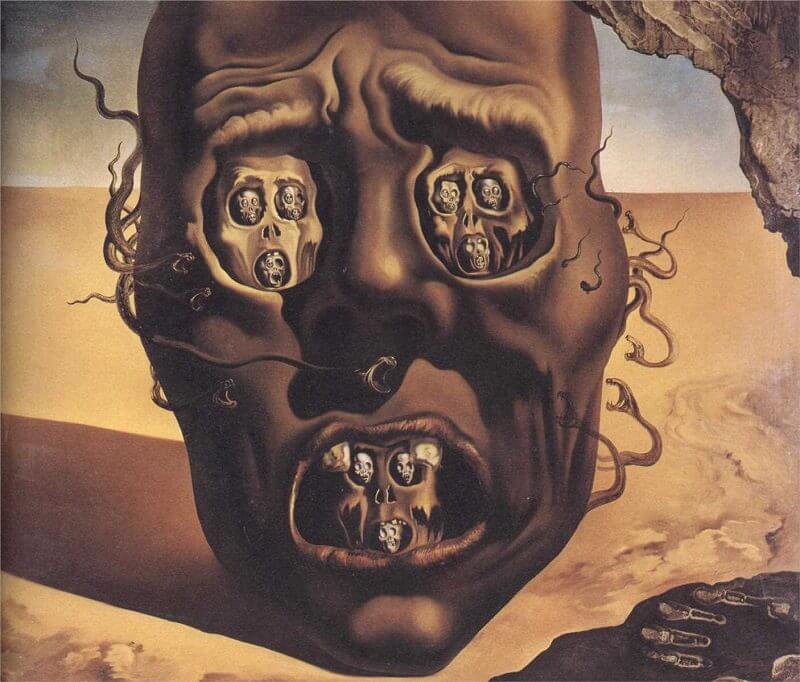
Salvador Dalí is i of the nigh well-known surrealist painters in history whose piece of work focused mainly on subjects that were at the forefront of the Surrealist move.
Many of his paintings involved portraying somewhat normal figures in very distorted and unusual ways that seemed to catch the attention of the viewer and cause them to call back about the subject in a different manner.
I of Dalí's more famous paintings is titled The Face of War and was done in 1940 at a time when World War II was ramping upward across Europe. Dali was a native of Kingdom of spain and was no stranger to the horrors of war. This painting depicts a giant horrifying head that is filled with ghastly faces in the eyes and oral fissure of the figure.
Dalí's message was clear, at that place is nothing skillful or pleasant about war and only horrible, dreadful things come of it. He would proceed to paint other works that worked as his own form of protest against the war that gripped the earth in the 1940's.
10. The Severed Heads – Theodore Gericault
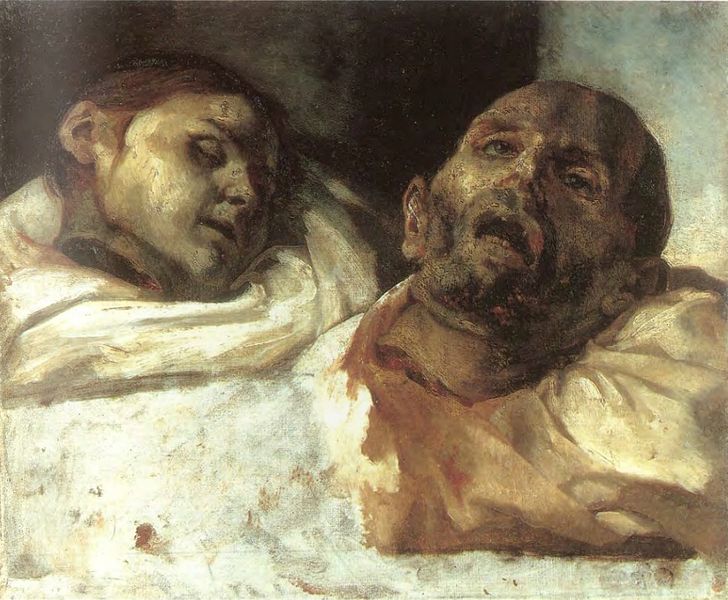
Theodore Gericault was a French painter built-in in the belatedly 18th century. He was a somewhat prominent figure in the Romantic motion and many of his more notable works featured some of the more than widely-recognized works from the era.
He was no stranger to creating dark paintings as he is credited with painting works like The Raft of Medusa and others with a sinister theme.
One of his more controversial works that is remembered as one of the more scary paintings from history is titled The Severed Heads. Painted in 1818, the work depicts ii severed human heads posed on a white cloth.
These heads are gruesomely depicted in vivid detail and are viewed every bit being in some of the initial stages of decomposition, which adds to the painting'southward horrifically scary nature.
yimhatemselithe1943.blogspot.com
Source: https://www.artst.org/scary-paintings/
0 Response to "10 Most Famous Scary Paintings for Halloween"
Post a Comment